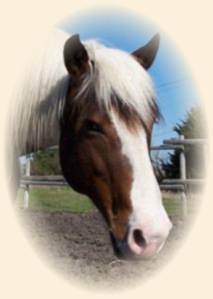The Body Language of Horses

The snorts, nickers, neighs, whinnies, bellows, squeals and screams of horses are meaningful only in conjunction with the body language of the moment or the situation of the moment, or both. The sounds are best understood as punctuation marks or emphases.
This is a basic premise of The body Language of Horses by Tom Ainslie and Bonnie Ledbetter. They contend: "In attempting to develop a satisfactory relationship with a horse, it is enormously useful to understand the animal's vocabulary of pantomime and sound." They expand on this to declare, "… truly effective communications depend on matters more fundamental than language. To respond adequately to the wants and moods expressed by the horse, we must understand the primary facts of equine nature.
Tom Ainslie, a leading authority on race handicapping, states that this is Bonnie Ledbetter's book. "It consists of her special knowledge and her unique point of view, which derive from a life of deep study, practical experience and, more fundamentally, an abiding respect for the integrity, dignity and sensitivity of animal life." He goes on to write:
…her mind is free of the sentimentality that attributes human faculties to horses. On the other hand, she rejects the ancient orthodoxy that depicts a successful relationship between human and horse as triumph of masterful man over broken beast.
Ledbetter believes "…the fracases that punctuate dealings between horses and handlers are almost invariably caused by defective human understanding and contribute inevitably to the deterioration of the horses." Conversely, "Handlers who recognize and accept equine individuality and modify their methods accordingly are invariably more successful than those who do not."
Often, a handler "punishes the horse for being a horse." The authors feel that "Equine stupidity is less often instrumental in the downfall of a horse than is the handler's unreasonable notion that the animal should offer more understanding than it gets in return."
Knowing the nature of horses is fundamental to understanding the concepts presented. Everything must be taken into consideration. "…in real life the horse integrates it faculties [physical senses], responding to each new stimulus with as many of them as possible." It is well known that horses have very keen senses. The authors state:
Because its senses of hearing, touch and smell are exquisitely acute, it performs feats that tax human credulity and give rise to theories about extrasensory perception, telepathy, and even miracles.
Most people have heard that a horse can sense if you are scared. The authors explain this as follows:
An even slightly tense or apprehensive rider is unaware of the disturbing messages transmitted through knees, hands or seat to an increasingly impatient or demoralized horse. And the muscle language of a confident rider helps to relax and embolden a horse.
Most people have heard about the importance of paying attention to a horse's ears. The authors contend that "…the motion of the ears and the positions in which they come to rest are basic elements of the animal's body language." They go on: "…in combination with other elements of body language, the ears state the nature of the horse's trouble almost as explicitly as speech could."
While the authors recognize practical limitations in dealing with horses, they state that "…the handler walks a fine line. When human convenience becomes too oppressive to the horse, it suffers in mind and body." They give the following example:
Although a barn provides shelter, horses neither need it nor appreciate it. They merely adapt to it. They are most comfortable under open sky, and sleep more securely when their senses of smell and hearing are unhampered by roof and walls.
The convenience of keeping a horse in a stall creates its own responsibilities. Whereas horses grouped in paddocks or fields can groom each other and roll at will, confined horses must be groomed by their confiners. Neglecting this brings consequences:
When grooming is neglected by stable help, a horse tries to find relief by abrading its skin on walls, posts and fences, often damaging them and itself and, worse, creating difficulties with its handlers, who then accuse it of vices.
On the other hand, the authors contend that "…conscientious grooming increases rapport with the horse, builds its confidence and is a powerful aid to successful training." They go on to say the following about horses: "Their generous response to reasonable treatment is a function of their mentality and disposition." But this has its reverse side as seen in "…the balkiness and sourness and general deterioration with which they respond to unreasonable treatment."
A fundamental principal of the authors is that "No horse should be deprived of play." This can be taken a step further: "The young horse that is allowed to regard work as fun learns its skills most rapidly and applies them most willingly."
Along the same line, the authors add: "…it is always better to work with the horse in terms of its current level of development rather than punish it for its nature." In explaining this, they add: "By suspending a new challenge until the horse is plainly ready for it, the handler gets prompter, happier and longer–lasting results." The thought is:
Persons unwilling to make brief, tactical concessions to horses should not try to solve equine problems, being much more likely to cause than solve them.
The authors state: "Horses learn. They learn especially well when allowed to do so at their own normal pace, without violence." Thus, "A calm, matter–of–fact handler gets best results."
Some of the contents of this book are direct towards the racing industry. In fact, the authors include advice on how to pick the most likely winners and avoid the obvious losers. But this book has plenty of information useful to anyone who works with horses.
Often, the best way to solve a problem with a horse "…is to earn the horse's acceptance by riding more competently."